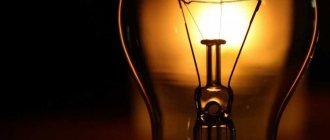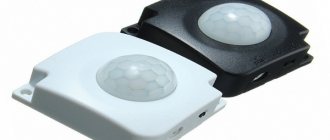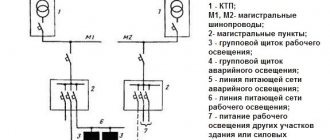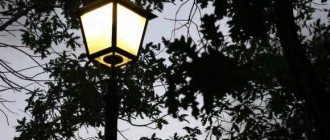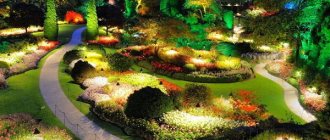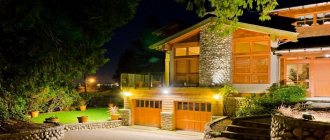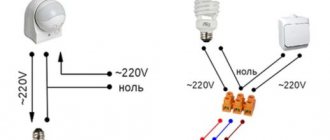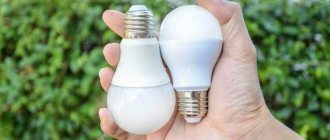Design Features
Outdoor lighting fixtures are different from indoor LED fixtures. The differences relate primarily to the design. The interior of the lamps is equipped not only with lamps, but also with special lenses. The latter are designed to focus the light flux into a beam and direct the light in the desired direction. The beams can be narrow or wide, bright or providing diffuse illumination.
Another feature of LED lights used outdoors is the presence of a durable, moisture-proof housing. The device must be reliably protected not only from aggressive weather factors, but also from vandalism (that is, mechanical damage).
A typical LED device has the following components:
- base;
- a housing with vertical fins (making heat removal more efficient);
- LED board (several lamps are installed on it at the same distance from each other);
- scattering translucent sphere;
- electronic driver (controls the supply of power).
When manufacturing equipment for outdoor lighting, special attention is paid to the strength of the housings, as well as their resistance to various environmental factors. As a rule, aluminum is used. They allow you to protect the equipment filling from rain, snow, hail, temperature changes and moderate mechanical influences. If there is a need for a particularly durable case, it is recommended to opt for a steel case, which has the best anti-vandal characteristics.
Selection of lamps
The process of selecting lamps can be divided into several stages - this is the determination of the nominal parameters of the required lamps and their direct selection. Let's look at each of these aspects.
In this video, an expert will share tips on how to choose an outdoor LED lamp.
Determination of nominal parameters of street lamps
LED lamps for street lighting are chosen for a reason. Before going to the store, we must decide on their quantity, luminous power, color temperature and type of reflector.
And the answers to all these questions are taken not just out of thin air, but based on the street lighting project. And even if you just want to create lighting for your local area, you still need a project. And it is not at all necessary to contact design organizations for this. You can create such a project with your own hands.
Lighting standards
- To do this, we first need to decide on the area and type of surface that we will illuminate. This is necessary to calculate the luminous power of lamps and determine their number.
Lighting standards for hospitals, sanatoriums and children's institutions
- Let's start by determining the type of surface. Why is this so important? There is such a regulatory document as SNiP 23-05-95, which normalizes the minimum and average illumination for various rooms, as well as for objects outside buildings. It will help us determine the minimum required illumination for our object.
Lighting standards for recreation areas
- Of course, these standards are more suitable for industrial and public facilities, but a private person can also find answers to many questions in them. For example, we need to illuminate a playground in the yard; for this we can adopt the standard that exists for educational institutions and which is 10 lux. And for lighting the steps on the path, you can adopt the corresponding standard for pedestrian tunnels, which is 20 lux. If we just need to illuminate a path in the garden, then we can adopt a standard for lighting park alleys, which ranges from 2 to 6 lux.
Road lighting standards
- We need to determine the standard value in order to determine the total value of the luminous flux of all lamps for a given object. To do this, simply multiply the area that you want to illuminate by the normalized value.
Lighting standards for pedestrian areas
Note! Of course, the majority of our fellow citizens determine the required luminous flux power “by eye.” But in this case, you will create either insufficient illumination, which will have a bad effect on the feasibility of this lighting as such, or you will create too bright lighting, because of which the price of its operation and installation may increase significantly. Therefore, it is better to use the calculations of research centers that have calculated the optimal lighting parameters for various objects.
- Now we need to decide on the number of lamps, for which we need to know their locations. There are two options here - the first is to use more lamps, but of lower power, or to use fewer lamps, but of higher power.
Uniformity of outdoor lighting
- But in pursuit of fewer lamps, we must not forget about such a parameter as lighting uniformity. Clause 5.13 of SNiP 23-05-95 regulates it separately. So the difference between the maximum and average illumination for objects with a norm of more than 6 lux is 1 to 3, for objects with a norm of 4 to 6 lux the ratio should be no more than 1 to 5, and for objects with lower norms no more than 1 to 10 .
- Having decided on the number of lamps, we can understand what kind of luminous flux power we need for an LED street lighting lamp. To do this, it is enough to divide the total power of the luminous flux by the number of lamps.
The photo shows the graduation by light temperature
- Now we need to decide on the color temperature of the lamp. This option is selected based on your design preferences. It is measured in Kelvin (K). The higher the value, the closer the color is to the blue spectrum. Light around 2200K is considered warm, the kind of light emitted by a regular incandescent lamp. Values around 6500K and above are considered cool light. Natural daylight is approximately 4000K.
Street lamp components
- Well, and finally, let’s clarify the type of reflector that we talked about at the very beginning of this section. It is important for us in the context of the type of lighting - whether it will provide directional or diffused light. Spotlight luminaires are usually used for architectural lighting of buildings. If we choose an LED street lighting lamp, then we should opt for a reflector that provides diffused light.
Selection of LED lamps
After we have decided on the number of lamps, their luminous power and color temperature, we can go to the store. Now we need to choose a good lamp. But how to define it?
| To begin with, you must understand that an LED street lighting lamp is a plate with a certain number of LEDs assembled. The number of LEDs in each individual lamp is usually selected in such a way as to achieve a certain luminous flux intensity. But it is quite possible to create custom-made lamps. |
| The main distinguishing feature of LED lamps is that they heat up and require a special radiator to remove the heat. If this is not very noticeable in ordinary LED lamps for the home, then in much more powerful street lighting lamps this should be given the closest attention. |
| To remove heat from LEDs, such lamps have a special radiator. But if you don’t see it, it doesn’t mean it doesn’t exist. Recently, to remove heat from LEDs, lamp housings are increasingly being used, which are made of aluminum, which has higher thermal conductivity properties. |
| In addition to the radiator in the lamp, you should definitely pay attention to the so-called driver. This is the name for a device that converts alternating current into direct current and limits the current to each individual diode. It is current limitation that is one of the most important parameters for the long service life of each individual diode and the lamp as a whole. |
| At the moment, there are two main types of drivers: capacitor and electronic. The former are an order of magnitude cheaper, but when used, LEDs can produce a pulsating light flux, which has a negative effect on human eyes. This is especially noticeable in drivers with low capacitance or no capacitor at all. Electronic drivers are an order of magnitude better in this regard, but they have one big drawback - they are much more expensive. Cheaper models cause significant interference. You can learn more about this issue in the video. |
| An important factor is the degree of protection of the lamp from dust and moisture. After all, it will be under atmospheric influence. According to GOST R IEC 60598 – 2 – 3 -99, this degree of protection must be at least IP33. But in practice it is better to use lamps with IP44 and higher. |
| Also, when choosing the technical characteristics of a lamp, pay attention to its mounting. It must correspond to its installation method. Outdoor lighting fixtures can be mounted not only on a pole, but also on a cable, wall, pole crown or pipe. The lantern mounting must also correspond to the chosen installation option. But we'll talk about this in the next section. |
Advantages and disadvantages
The advantages of outdoor LED sources include the following qualities:
- Economical consumption of electricity. LED devices consume 10 times less electricity compared to incandescent light bulbs and are twice as economical as fluorescent lamps.
- Long service life. Used only at night, the lamp can last a quarter of a century or even longer.
- Resistance to cyclic loads. This means that LED lights can cope well with frequent switching on and off of the device. At the same time, the total resource is not reduced, which distinguishes diode devices from incandescent lamps and other light sources.
- Resistance to high and low temperatures, as well as temperature changes. Devices of this type can be operated at temperatures from 50 degrees below zero to 50 degrees above zero.
- Ability to withstand mechanical loads. Devices designed for street lighting retain their performance even after being dropped from a considerable height onto hard bases.
- No inertia. This means that full power is achieved almost without a pause - immediately after connecting the electrical circuit.
- No noise during operation.
- LED lamps do not flicker.
- Environmentally friendly. Diodes are made from environmentally safe materials. There is no need to take any special measures to recycle LED lamps.
- Fire and explosion safety.
Outdoor systems based on LEDs also have disadvantages, including:
- High prices for devices. This drawback is considered the most significant. Over the course of many years, purchasing an LED device will pay for itself many times over. However, from a financial and psychological point of view, it is not so easy to spend a one-time amount that significantly exceeds the cost of purchasing conventional incandescent lamps.
- Thermal degradation of high power diodes. Over time, devices with a power of more than 50 W lose their brightness. To avoid this drawback, reliable heat dissipation is needed. The manufacturer himself can partially slow down the degradation if he does not skimp on the quality of the device components. Particularly high demands on the quality of a lighting device are imposed when it is used in hot climates.
- Diode components are sensitive to voltage surges. Even a one-time drop can lead to lamp failure. To reduce the likelihood of diode damage, preference is given to high-quality power supplies. If the lamp is placed on a regular base, then a voltage stabilizer is connected to the electrical circuit.
Note! The last two of these disadvantages are inversely related to the first (price). The higher the cost of the lamp, the better the quality of the materials used in its assembly. Accordingly, in expensive models the likelihood of thermal degradation and the level of responsiveness to voltage surges are lower than in cheap devices.
Selecting light bulbs for a lamp
Comparative characteristics for all types of lamps
The following types of lamps are used to operate street lamps:
- Incandescent light bulbs. They are characterized by high power, while spending a lot of energy. Unsafe.
- Halogen. They are a modification of an incandescent lamp, but a buffer gas is used inside the bulb. This reduces temperatures and increases service life.
- Gas discharge. They work with decorative lighting. They are characterized by high energy efficiency and are installed in mushroom-shaped lamps and cabinets.
- Mercury lamps. They are practically not used for illuminating dachas and cottages.
- Metal halide. They illuminate a large area and provide light as close to daylight as possible. The downside is the high price.
- Xenon. They give a soft warm color and are highly productive.
- Luminescent. They have high light output, are economical and have a long service life. Depending on the power, they can have a large illumination radius.
- LEDs. The safest and most efficient light sources. Diode dumps are used for both main lighting and decorative lighting. They have a wide range of colors. LED street lighting lamps are environmentally friendly and safe.
The choice of the right lamps depends on the purpose of the light source and financial resources.
Lamp placement method
Based on their location, LED street lights are usually divided into four types:
- Hanging.
- Wall-mounted.
- For installation on poles.
- Built-in.
From a design point of view, the pendant model is a sealed casing with an LED placed in it. Such devices are fixed on a cable or chain to a beam located horizontally at a certain height from the ground. Although outwardly hanging models seem fragile, they are excellent for outdoor use, regardless of weather conditions. The mounting of the pendant lamp can withstand mechanical loads associated with the accumulation of snow and icing in the winter season. The elements of the lighting device must withstand all kinds of mechanical stress, including hail impacts.
The wall lamp (sconce type) is a universal model. It can be installed on any vertical surface if it has the necessary rigidity. Wall-mounted models are especially popular because they have high decorative properties (in addition to the main function - lighting). Wall lanterns are available in a variety of styles, including classic, retro, modern, rustic, etc. The housings of wall lamps are usually made from light metal alloys, and glass or plastic is chosen as the material for the lampshade.
Note! The level of protection against external influences for wall lamps should not be less than IP44. This protection allows you to protect the internal elements of the device from moisture (snow, raindrops) getting inside.
The next type of LED street lights are installed on poles. To ensure there is enough light on the street at night, lanterns are mounted on masts at a height of up to 7 m. The height of the light source depends on the power of the lamp: the higher this indicator, the higher the height the lantern is installed.
In some cases, it is possible to use built-in lamps; they are convenient because they are invisible during the daytime. Built-in devices are used to illuminate fountains, architectural features of buildings, and sculptures.
The main part of the lighting fixtures is made using LEDs with a power of up to 50 W. The brightness of such a diode is similar to a 500-watt incandescent lamp. An LED of this power is enough to illuminate an area of a thousand square meters.
Choosing street lamps for a pole (for a summer residence)
Installation of LED lamps
LEDs are semiconductors, the main elements of which are a compact but quite powerful crystal. The electric current that passes through the diode is converted into a stream of light.
One of the most labor-intensive stages in creating high-quality lamps for lanterns was growing crystals. There are several domestic and foreign companies that are engaged in this process. The grown components are placed on plates, and then treated with a protective layer and connected to the contacts. Each of the light diodes is about the size of a pea. Since the lanterns on the poles must shine brightly and powerfully, lamps are used here, which consist of several layers with light diodes.
To enhance functionality, specialized optical lenses are additionally installed in the product. The latter are capable of focusing the flow of light from many crystals and orienting it in the required direction, which the device should illuminate. Since the body of an outdoor lamp must withstand various influences of natural phenomena (dust, strong wind, precipitation), high-quality products use aluminum, which is resistant to corrosion. The base of the lamp is fastened to the body, and then the device is mounted on a pole. Such a flashlight can last at least 20 years if it is not subject to strong shocks or other similar influences.
Varieties
Street lamp posts are classified into different types. For example, they are capable of emitting diffused or directional light. In the first case, the devices are used to illuminate large areas, and in the second, for a small area. Moreover, according to the type of lighting, they can be single or double.
Other products can be divided into decorative and industrial, which means they are used as a main or additional light source. When choosing a lighting device, do not forget about its style. They come in classic, baroque, hi-tech and modern styles. It’s worth choosing depending on how the exterior is decorated. According to the method of fastening and purpose, lanterns can be floodlight, park, cantilever and ground.
Console
The classic version of such a device is a lantern, which is placed on a pole. The devices are suitable for illuminating highways, streets, highways and alleys. They can be found in other, wider areas, including parking lots, enclosed spaces (workshops, warehouses, hangars), etc.
Park
Such lighting devices can be decorative or industrial. On the one hand, they are capable of illuminating park alleys, and on the second, they are used for decoration and the desire to diversify landscape design. Quite often the light from them is diffused, with a huge coverage angle. Quite often this parameter reaches up to 360 degrees. To install diode park lights, you can use the same building facades, pillars, low supports and parameters. They can also be installed on the ground.
Ground
Solar pole street lights can be installed directly into the ground. To ensure their high degree of durability and functionality, manufacturing companies monitor the mechanical strength of the products, as well as their tightness. At the same time, the strength of some of the models that are designed for steps and paths makes it possible to even step on them. They are used as decorative elements of landscape design and lighting, but at the same time they are capable of providing a powerful flow of light, which is needed to illuminate objects that are located at low heights.
Ground lighting devices are often used near a fountain, along park alleys or in the courtyard of a country house.
Spotlights
Such street lamps on poles for dachas are considered universal. To solve problems of illuminating distant objects or search tasks (squares, monuments, architectural structures), more narrowly targeted products are used, and flooding devices are used to illuminate nearby structures and territories (front doors in residential buildings, administrative buildings or guarded parking lots). They are also actively used in the field of landscape design. They produce spot devices with different sizes, shapes, power and designs, due to which you can always find those lighting devices that are ideal for decorating an area by illuminating elements of a landscape or architectural structure.
Spotlights are installed on the facade, lamp posts or roof of the building, or on the ground. It is especially important to note autonomous lighting devices based on light diodes. They can be used even in areas where there is no electrical supply. Such products are usually supplemented with solar panels and batteries, which provide recharging during the day. To save battery power, devices are often supplemented with motion sensors and light levels. The service life of devices without replacing the solar panel and battery will greatly depend on the quality of such components.
Types of street lamps
There are several types of lamps used to illuminate street objects:
- Landscape lamps. Their power ranges from 3 to 10 W. Landscape lighting devices are used to illuminate flower beds, lawns, garden sculptures, the banks of ponds, and swimming pools. For illumination, you can use LED garlands, which contain many multi-colored light bulbs.
- LED Strip Light. It is a flexible board with built-in contacts and LED lamps (SMD modification). To control the current supply, resistors are installed on the tape. The tapes have an adhesive base on one side, on which the light source is attached to any surface. A special feature of the LED strip is its high level of moisture protection. The market offers ribbons with a color replacement function (a special controller is responsible for this). Dimmable strips have a lighting brightness control function.
- Linear luminaires. They are distinguished by moderate brightness and comfortable contrast. The light is pleasant to the eyes and calms the nervous system. The service life of light bulbs is 12-15 years. Externally, linear devices resemble fluorescent ones: an oblong bulb with diodes and electronic components. However, the bulb of the LED lamp is not made of thin glass, but of reliable polycarbonate, which is very difficult to break. In addition, there are no hazardous substances such as mercury inside the lamp.
- Console lamps. Such models are used to organize light over large areas (streets, highways, parks, courtyards of buildings). The name of this type of lighting fixtures is due to their fastening using a special bracket (console). Aluminum is used as a construction material for the body, and the optics are covered with silicate glass (for strength). The body itself consists of two elements connected by a hinge. Cantilever models are installed on vertical supports or on walls.
LED lamp design
Any LED lamp consists of:
- Housing having a variety of shapes;
- The LED board, which is an aluminum alloy board on which LEDs are mounted, can be of any quantity, depending on the purpose;
- Metal sealed lead-in, which is intended for inserting wires and cables into electrical enclosures to protect them from various mechanical damage and from moisture and dust;
- A driver, which is a small device designed to supply current to the LED board; roughly speaking, a driver is a current source;
- Matte diffuser made of various materials, the most commonly used are polycarbonate, polystyrene, polymethyl methacrylate. It is necessary in order to protect the inside of the lamp from moisture, dust, and so on, to ensure the most effective distribution of light.
Important factors when choosing a luminaire
When purchasing an LED device for street lighting, it is recommended to pay attention to the following factors:
- Scattering of a light beam. The light stream can be round or oval. In the first case, it will be overly bright. Therefore, an oval shape is preferable, giving a softer glow.
- Light intensity. It is best to have control over this parameter, which is achieved using a dimmer.
- Temperature of light. Warm white tones are achieved at a temperature of 2.7-3.5 thousand K. In rooms intended for performing any work, the optimal temperature is considered to be 4-5 thousand K.
- Case quality. It must be durable to withstand the effects of negative environmental factors (weather conditions and mechanical loads).
- Resistance to power surges.
- Regardless of the type of lamp, it can be controlled using a remote control. This makes it possible to change the colors and brightness of the lighting.
- There are models on the market with light sensors. The sensor detects movement at a certain distance from the lamp and transmits a signal to turn the light on or off. The function is convenient because it saves electricity. The light turns on only when there is a need for it.
When choosing a lamp for the street, its appearance is of certain importance. The design is especially important if the lantern acts as decorative lighting in a personal plot or in a park. In this case, you should keep in mind not only the technical parameters of the equipment, but also its shape, nuances of stylistic design and the color of the case. The spherical LED lamp looks impressive and illuminates the area with high quality. The main feature of such models is their unusual design.
An example of a good choice is LED lamps from Bellson. These are powerful (60-80 W) devices for outdoor use. Used to illuminate pedestrian crossings, parking lots, park areas, land around buildings, etc.
Bellson products are characterized by a luminous flux of 6500 lumens and a cold glow (temperature 5.5-6 thousand K). All devices have a degree of protection IP65, thanks to which the electronic filling is not afraid of dust and directed jets of water. Operation of Bellson lamps is possible at temperatures from 40 degrees below zero to 40 degrees above zero.
Bellson lamps maintain performance characteristics for 25 thousand hours. The compactness of Bellson lamps allows them to be installed without much difficulty.
The process of installing street lamps
The process of connecting a purchased street lamp begins with its installation. It must be carefully secured to the selected area of the wall, ceiling, or area. The exception is floor lamps in the form of garden figurines - they are simply placed in place. Since the products are available in several types, installation methods also vary.
- Cantilever mount. The lamp is sold complete with a decorative bracket, characterized by exquisite, patterned shapes. Very often, this role is played by a figured base made of forged or cast metal in the form of fancy patterns, vines, and flowers. It is attached to a wall or other vertical surface (post, column) using anchors or bolted connections inserted into the box. Before installation, it is necessary to take measurements, mark the locations of fasteners, and drill holes. The lantern itself can be removable, or be integral with the bracket, located on top, on the side or suspended.
- Also, products on the console can be secured using steel mounting tape. To do this, it is enough to attach the bracket to the surface, thread it through the holes or put two tapes on the base, top and bottom, so that the product does not “walk,” and tighten the fastening tightly. This method is applicable only for pillars, columns, metal beams and other supports that do not have a very large diameter.
- Recessed lamps are built into the surface of a wall, sidewalk, steps or other suitable surfaces. First you need to use an electric drill to make holes of the appropriate size and depth. Then a mounting box is installed inside into which the wires are passed. Connect to the working contacts of the device, insert the lamp. Then fix the top cover with the lampshade.
- Hanging products are attached to special hooks mounted in the ceiling. Since there are often strong gusts of wind outside, it is necessary to choose reliable, metal hooks, otherwise there is a risk of the entire structure falling.
- Ceiling lights are mounted on a metal mounting strip. It is nailed to the base with two dowel nails.
- Floor lamps and garden posts require strong fasteners, since thin vertical supports are not stable enough. This requires a solid concrete foundation. It can be part of an architectural ensemble (terrace, staircase, path made of reinforced concrete slabs covered with tiles), or it can be poured separately. Sometimes ready-made reinforced concrete blocks of square, cylindrical or rectangular shape are used. They are left open, or buried and masked with a lawn, a layer of decorative gravel or colored pebbles. Before pouring, hollow tubes for the cable are laid inside the formwork so that the inlet and outlet openings are accessible. The lights are screwed to the base with powerful bolts or anchors. Also, you can concrete several metal pins, according to the number of holes in the base of the lamp support. The pole is simply installed on them, after which the fastenings are fixed in any convenient way.
Even a child can handle the installation of solar-powered ground LED lamps. Simply stick the pointed end of the post into the soil. But for products powered by electricity, you will have to connect wires.
- 12 266 ₽
LED waterproof strip Horoz 5W/m 156LED/m 2835SMD RGB 50M 081-006-0002 Gray
Add to cart
LED strip Globo 9M cool white 13.8W 38971 White
Add to cart
LED strip Paulmann 9.6W/m 39LED/m warm white 3M 70592 White
Add to cart
LED waterproof strip (10803) Uniel 14.4W/m 60LED/m 5050SMD RGB 50M ULS-5050-60LED/m-16mm-IP67-220V-14.4W/m-50M-RGB Multi-colored
Add to cart
LED waterproof strip (UL-00001860) Uniel 7.2W/m 30LED/m 5050SMD RGB 5M ULS-F20-5050-30LED/m-10mm-IP65-DC12V-7.2W/m-5M-RGB Smart Multi-colored
Add to cart
LED strip Volpe (UL-00004353) 14.4W/m 60LED/m 5050SMD warm white 5M ULS-Q221 5050-60LED/m-10mm-IP20-DC12V-14.4W/m-5M-3000K White
Add to cart
LED strip (10777) Uniel 9.6W/m 60LED/m 2835SMD cool white 3M ULS-Z01-2835-60LED/m-8mm-IP20-DC12V-9.6W/m-3M-DW White
Add to cart
Matte diffuser Uniel UFE-R06 Frozen UL-00000613 White
Add to cart
Useful tips
A few tips to help when creating a street lighting system with LED devices:
- There is often an opinion that LED strip is not the best option for the street. This is motivated by the fact that, despite the high cost of the tape, it is not suitable for street use due to its external fragility. In fact, such a statement is not true. LED strips can withstand mechanical loads, temperature changes and high humidity. The advantage is that there is no need to use any improvised devices when installing it. Simply stick the tape onto the surface and it is ready for use.
- The lamps are installed at a height of 4-7 m. Especially powerful models are up to 10-11 m. This will optimize the dispersion of light throughout the area.
- It is recommended to install built-in lamps at the same distance from each other. This is the only way to ensure harmonious lighting and its normal intensity.
- The power of flashlights depends on the purposes for which they are used. To illuminate landscape details, a lamp from 3 to 10 W is sufficient. Lamps for local areas should be more powerful - 50-60 W. Floodlights of 100 W or more are used to illuminate large-scale objects, such as industrial enterprises, wide avenues, and highways.
Characteristics and types of lamps
For street lighting, incandescent lamps are used, which have a high luminous flux power and consume a significant amount of energy. When halogen gases are pumped into glass flasks, the service life of street lighting lamps increases.
More popular are gas-discharge lamps, which can be:
- Mercury (DRL). In such lamps, the flow of light is generated due to discharges of electricity in mercury vapor. They are used for street lighting of large areas, but they operate with the release of a large amount of heat, therefore they are made of heat-resistant materials.
- Metal halide (MHA). Street lighting lamps with halides, which are combined with mercury vapor, provide good visibility and are in demand at sports facilities.
- Sodium (DNAT). Sodium vapor lamps are unstable to humidity and sudden temperature changes, so special glass is used to make the flasks.
- Induction. When using them, street lighting is formed using plasma glow that occurs in ionized gas. To control street lights you will need an inductor.
- Xenon. The bulbs of such lamps combine metal salts and an inert gas, and the flow of light is formed due to electrical discharges passing through tungsten electrodes.
Fluorescent lamps are also used in urban areas. They are characterized by a long service life and good luminous flux performance. Modern models of street lamps operate practically without noise and are not prone to flicker. The service life of fluorescent devices is reduced by frequent switching on and off.
Outdoor LED lamps are especially popular in the construction of lighting systems. They are characterized by the following:
- long service time;
- high efficiency and color rendering index;
- economical consumption and energy consumption;
- resistance to voltage changes and vibrations.
LED street lighting fixtures do not flicker or distort the environment, creating safe conditions for driving vehicles. Thanks to the special design of the device housing, protection from dust and moisture resistance is ensured.
Lighting organization
To ensure high-quality lighting, it is necessary to perform a number of organizational and technical measures:
- Create a project where the brightness of the directional light, the level of illumination and all other parameters specified in SNiP, as well as the PUE, are calculated.
- Consider the location of all the lamps (if there are several of them in one area).
- Describe the lighting system control circuit.
- Make a drawing of the lighting scheme.
- Select lighting fixtures that comply with the technical conditions and plan.
- Install lamps.
It is also necessary to take into account the rules for regular maintenance of installed equipment.
Types of street lighting
Outdoor lanterns differ from home lamps in that they have greater endurance (in fact, you don’t have to change light bulbs on high poles every week), resistance to humidity and frost (a home lamp will definitely be uncomfortable in the rain or snow), and airtightness.
Types of street lighting lamps by type of lampshade:
- Floor lamps. They are the ones who shine from high pillars on the streets at night. In suburban areas, floor lamps are also very popular (the poles, however, are smaller). On some particularly technologically advanced poles, you can even adjust the height of the lamp.
- Hanging. Such devices are usually suspended from the ceilings of gazebos, canopies, and so on.
- Wall-mounted. Such lamps are attached to the walls of various buildings, be it a twenty-story building, a country villa or a barn in the village.
- Built-in. These lights can often be found built into the driveway to better illuminate an entryway, such as a garage.
There are everyday lamps that perform the function of ordinary lighting of the area. But for suburban areas, ordinary lamp posts, as a rule, are not used. For this purpose, there are decorative lamps that are chosen in the store or made to order. They can be shaped like a mushroom with a cap, a gnome, and so on. In addition, they can cast light in different ways: straight, striped, figured.
Modern technologies make it possible to install motion sensors on lamps. Surely many will remember: passing by some rather dark and deserted place, a light bulb suddenly lights up.
https://youtube.com/watch?v=fJSNxfu2RzU
Protection of street lamps
Outdoor light sources are often used in difficult conditions, so they must be protected from various factors. The most common problem is voltage fluctuations in the network. Protection that turns off the lamp when the voltage increases significantly allows you to extend its service life. Some models have overheating protection. This function is especially important when used in high temperatures. When a critical temperature value is reached, the power of the LEDs is automatically reduced, which leads to less heat generation. The housing of the street lamp must protect the LEDs and electrics from dust, moisture and mechanical damage. For outdoor use, it is recommended to use lighting devices with a housing protection class of IP 67-68. Such devices will not be damaged even if they come into direct contact with water. Outdoor LED lamps also differ in design, shape and size, and type of mounting. You can choose not only a classic model with a simple shape, but also a decorative street lamp that will become part of your landscape design.
You can choose a street LED lamp in the section: street LED lamps

